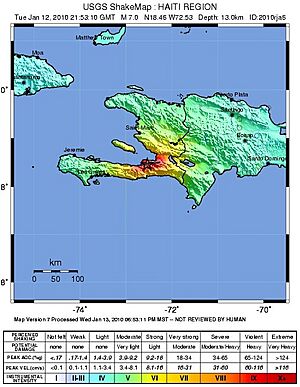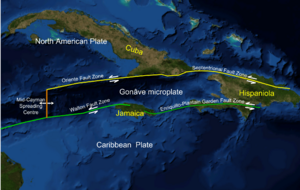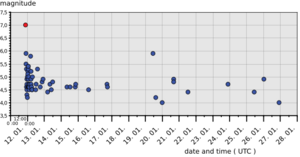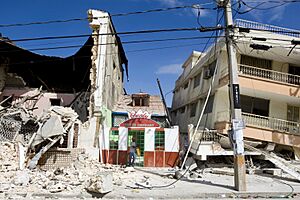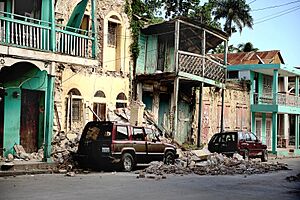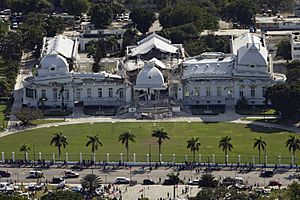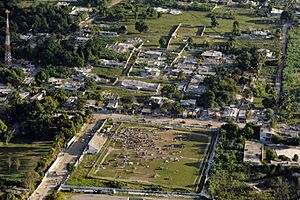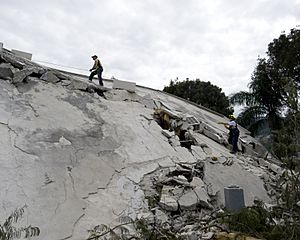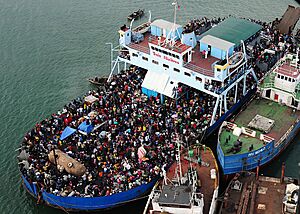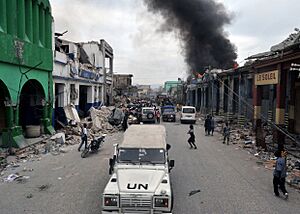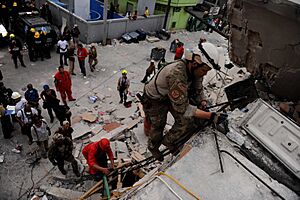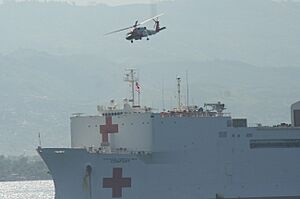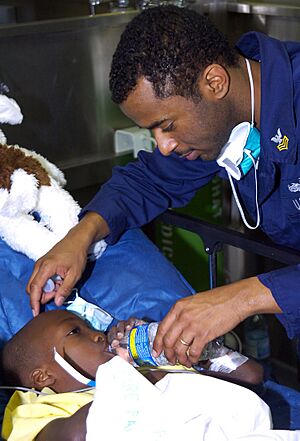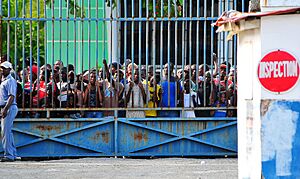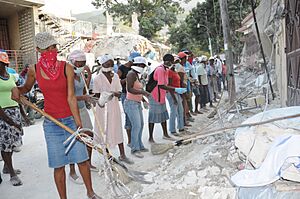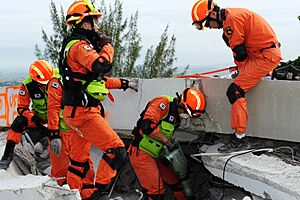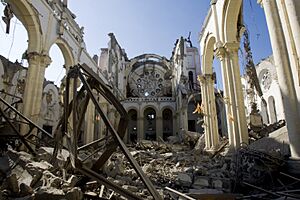2010 Haiti earthquake facts for kids

The heavily damaged National Palace of Haiti after the earthquake
|
|
| UTC time | 2010-01-12 21:53:10 |
|---|---|
| ISC event | 14226221 |
| USGS-ANSS | ComCat |
| Local date | 12 January 2010 |
| Local time | 16:53:10 EST |
| Duration | 30 seconds |
| Magnitude | 7.0 Mw |
| Depth | 13 km (8.1 mi) |
| Epicenter | 18°28′N 72°32′W / 18.46°N 72.53°W |
| Fault | Enriquillo–Plantain Garden fault zone |
| Areas affected | Haiti, Dominican Republic |
| Total damage | $7.8 billion – 8.5 billion |
| Max. intensity | X (Extreme) |
| Peak acceleration | 0.5 g |
| Tsunami | Yes (localized) |
| Casualties | 100,000 to 160,000 deaths (estimates vary, with some government figures higher) |
The 2010 Haiti earthquake was a very strong earthquake that hit Haiti on Tuesday, January 12, 2010, at 4:53 PM local time. It had a magnitude of 7.0. The earthquake's epicenter (the point on the Earth's surface directly above where the earthquake started) was near the town of Léogâne, about 25 kilometers (16 miles) west of Port-au-Prince, which is Haiti's capital city.
This powerful earthquake affected an estimated three million people. Sadly, between 100,000 and 160,000 people lost their lives, though some estimates were higher. It caused widespread destruction, especially in Port-au-Prince. Many homes and buildings collapsed or were badly damaged. Haiti, being a country with many people living in older or less sturdy homes, faced a huge challenge. This made the earthquake's impact even more devastating.
The earthquake severely damaged important buildings like the Presidential Palace, the National Assembly building, and the Port-au-Prince Cathedral. The headquarters of the United Nations Stabilization Mission in Haiti (MINUSTAH) also collapsed. Many countries quickly offered help, sending money, rescue teams, doctors, and supplies. However, damaged roads, communication systems, and the airport made it very hard to get aid to those who needed it most.
Contents
Understanding Earthquakes in Haiti
Haiti's Shaky Ground: A Look at Its History
The island of Hispaniola, where Haiti and the Dominican Republic are located, is a place where earthquakes happen often. This is because it sits on the edge of two large tectonic plates (huge pieces of Earth's crust) that are always moving. Over the years, Haiti has experienced many strong earthquakes. For example, in 1751 and 1770, major quakes destroyed much of Port-au-Prince. Another big earthquake in 1842 damaged many northern towns. In 1946, a powerful earthquake in the Dominican Republic also shook Haiti and caused a tsunami (a giant ocean wave) that led to many deaths.
Haiti is the poorest country in the Western Hemisphere. This means that many people live in difficult conditions, and buildings are often not strong enough to withstand natural disasters. Besides earthquakes, Haiti also faces many tropical cyclones, which bring heavy rains and floods. These natural events have caused a lot of damage and made life harder for the people of Haiti.
How the 2010 Earthquake Happened
The 2010 earthquake happened because of movement along a major crack in the Earth's crust called the Enriquillo–Plantain Garden fault zone. This fault is where the Caribbean plate and the North American plate meet and slowly grind past each other. For about 250 years, this part of the fault had been "locked," meaning it wasn't moving, and a lot of stress built up. When it finally broke, it released a huge amount of energy, causing the magnitude 7.0 earthquake.
The earthquake happened about 13 kilometers (8 miles) deep underground and lasted for about 30 seconds. The shaking was very strong in Port-au-Prince and nearby areas. People felt the earthquake in other countries too, like Cuba, Jamaica, and the Dominican Republic. Because the earthquake was shallow, the shaking was more intense and caused more damage than some other earthquakes of similar strength.
Aftershocks: More Shaking Followed
After the main earthquake, there were many smaller earthquakes called aftershocks. These are like smaller tremors that happen as the Earth's crust settles after a big quake. In the first few hours, dozens of aftershocks were recorded. The strongest one, with a magnitude of 5.9, hit about a week later near the town of Petit-Goâve. This aftershock caused more buildings to collapse, but thankfully, most people were sleeping outside by then, so there were fewer new injuries.
Localized Tsunami
Right after the earthquake, there was a small, localized tsunami in a fishing town called Petit Paradis. This was likely caused by an underwater landslide triggered by the earthquake. The sea first pulled back, then a "very big wave" rushed ashore, sweeping boats and debris into the ocean. At least three people were sadly swept out to sea.
Damage to Haiti's Buildings and Services
Impact on Essential Services
The earthquake severely damaged many important services. Hospitals in Port-au-Prince and other cities like Jacmel collapsed or were overwhelmed. This made it very difficult to treat the thousands of injured people.
The Toussaint L'Ouverture International Airport's control tower was damaged, making it hard for planes to land. The main seaport in Port-au-Prince was also badly damaged and couldn't be used right away. Roads were blocked by debris, making it nearly impossible to deliver aid and supplies to affected areas. Communication systems, including phone networks, were also disrupted. Many radio stations were knocked off the air, though some managed to start broadcasting again within a week.
Widespread Destruction of Buildings
The earthquake destroyed or severely damaged an estimated 250,000 homes and 30,000 business buildings. In Léogâne, near the epicenter, about 90% of the town's buildings were destroyed. Many government buildings, including the Palace of Justice and the National Assembly, were also damaged. The Presidential Palace was severely damaged, but President René Préval and his wife were safe.
Most of Port-au-Prince's city buildings were destroyed or heavily damaged. The education system was also badly hit, with about half of the country's schools and three main universities in Port-au-Prince affected. Over 1,300 schools and 50 health centers were destroyed. The headquarters of the United Nations Stabilization Mission in Haiti (MINUSTAH) also collapsed.
Life After the Earthquake
Immediate Challenges and Community Response
In the days and nights after the earthquake, many people in Haiti slept outside. Their homes were either destroyed, or they were afraid of more shaking from aftershocks. Buildings in Haiti often lacked strong foundations or steel supports, making them vulnerable. Even before the earthquake, Haiti faced shortages of fuel and clean water.
The government faced huge challenges because many of its buildings and records were destroyed. They worked with UN planners, but it was hard to organize everything. The airport's control was given to the United States to help manage the many aid flights.
Aid distribution was slow at first, leading to some unrest. However, many communities came together. People sang through the night, and groups of men helped with security while women organized food and hygiene. Hundreds marched peacefully, singing and clapping. Aid workers also needed to learn Haitian Creole quickly to communicate with people. The large amount of waste from relief supplies, like plastic bottles, also became a problem, blocking drains and increasing health risks.
Casualties: The Human Cost
The earthquake hit the most populated part of Haiti. The International Federation of Red Cross and Red Crescent Societies estimated that about 3 million people were affected. While the exact number of deaths is hard to know, estimates range from 100,000 to 160,000. Many aid workers, embassy staff, and public figures also lost their lives. Among them were the Archbishop of Port-au-Prince and many United Nations personnel.
Rescue and Relief Efforts
Immediate Response and International Help
Rescue efforts started right after the earthquake, with survivors helping to pull people from the rubble. Doctors, police, military, and firefighters from many countries arrived within days. Organizations like the International Committee of the Red Cross and Médecins Sans Frontières (Doctors Without Borders) worked tirelessly. They treated thousands of injured people, often performing amputations because of the severe injuries and lack of supplies.
Getting aid into Haiti was challenging due to the damaged airport and roads. There were delays in landing aid planes, but eventually, coordination improved. The US military, along with other nations, sent many ships and helicopters to deliver food, water, and medical supplies. The hospital ship USNS Comfort arrived to provide medical care.
By January 14, over 20 countries had sent military personnel. The US Navy had 17 ships, 48 helicopters, and 12 fixed-wing aircraft in the area, along with 10,000 sailors and Marines. They delivered huge amounts of water, food, and medical supplies.
In Jacmel, a city of 50,000, about 70% of homes were damaged. Canadian, Colombian, Chilean, French, and Sri Lankan teams helped there. British search and rescue teams were among the first to reach Léogâne, the town at the earthquake's center.
Within the first weekend, 130,000 food packets and 70,000 water containers were distributed. Nearly 2,000 rescuers from 43 groups, with 161 search dogs, were working. The Port-au-Prince seaport became partly functional by January 21, helping to offload humanitarian aid.
By January 23, the Haitian government officially ended the search for survivors, and most search and rescue teams began to leave. However, some survivors were still found weeks later.
Rebuilding and Recovery Efforts
Initial Plans and International Support
After the earthquake, many leaders, including US President Barack Obama and former presidents Bill Clinton and George W. Bush, worked to raise funds for Haiti's recovery. US Secretary of State Hillary Clinton visited Haiti to see the damage. President Préval highlighted the need to rebuild the government, clear roads, and improve sanitation.
Many countries and organizations pledged financial aid. The European Union, Brazil, the United Kingdom, France, and Italy all committed significant funds. The World Bank also waived Haiti's debt repayments for five years. Canada matched donations from its citizens, raising a large amount of money for relief.
The Haitian government began moving homeless people to safer areas and temporary camps where aid could be better organized. Many Port-au-Prince residents also returned to their home towns in the countryside.
Challenges and Progress in Recovery
Rebuilding Haiti was a massive task. Six months after the quake, much of the rubble remained uncleared, making it hard to rebuild. Over a million people were still living in temporary camps, often without electricity, running water, or proper sanitation.
In October 2010, a cholera epidemic broke out, which tragically affected many people. Cholera is a disease that spreads easily in places without clean water and good sanitation. Thousands of Haitians died from this outbreak.
One year after the earthquake, in January 2011, reports showed that recovery was very slow. Only a small amount of rubble had been cleared, and few permanent homes had been built. Many people were still living in crowded camps.
By January 2012, two years after the quake, much of the money pledged for reconstruction had not yet been delivered. Many Haitians remained homeless. Watchdog groups noted that a lot of money was spent on temporary solutions rather than permanent housing.
The recovery efforts faced further setbacks from other natural disasters. Tropical Storm Isaac in 2012 and Hurricane Sandy later that year caused more flooding and deaths, especially for the hundreds of thousands still living in tents.
By 2013, more than half of the earthquake debris had been removed. The cholera outbreak continued to be a serious problem, affecting many Haitians. While some progress was made in building new homes and repairing others, hundreds of thousands still lived in camps.
In 2016, Hurricane Matthew struck Haiti, causing more destruction and leading to an increase in the ongoing cholera epidemic. By March 2017, around 7% of Haiti's population had been affected by cholera, and thousands had died.
As of 2017, the United Nations reported that 2.5 million Haitians still needed humanitarian aid. Many people remained in camps, living in difficult conditions due to the earthquake's lasting impact. The journey to full recovery was still very long.
In literature
The Haiti 2010 earthquake has been depicted in the novel God Loves Haiti, by Dimitry Elias Léger.
See also
 In Spanish: Terremoto de Haití de 2010 para niños
In Spanish: Terremoto de Haití de 2010 para niños
- 2010 Haiti cholera outbreak
- 2004 Indian Ocean earthquake and tsunami
- 2018 Haiti earthquake
- 2021 Haiti earthquake
- List of earthquakes in 2010
- List of earthquakes in Haiti
- List of natural disasters in Haiti
- List of deadliest earthquakes


